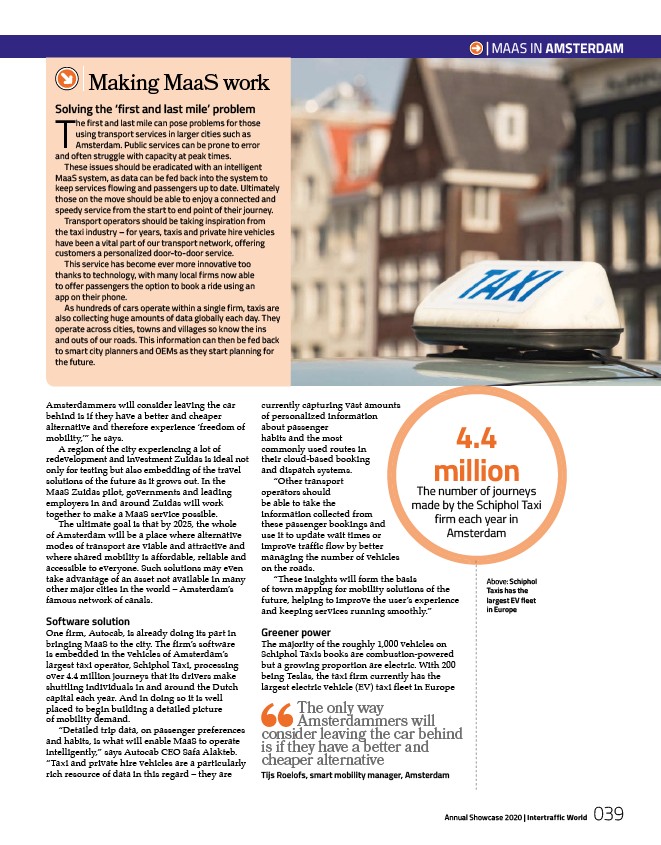
|MAAS IN AMSTERDAM
currently capturing vast amounts
of personalized information
about passenger
habits and the most
commonly used routes in
their cloud-based booking
and dispatch systems.
“Other transport
operators should
be able to take the
information collected from
these passenger bookings and
use it to update wait times or
improve traffic flow by better
managing the number of vehicles
on the roads.
“These insights will form the basis
of town mapping for mobility solutions of the
future, helping to improve the user’s experience
and keeping services running smoothly.”
Greener power
The majority of the roughly 1,000 vehicles on
Schiphol Taxis books are combustion-powered
but a growing proportion are electric. With 200
being Teslas, the taxi firm currently has the
largest electric vehicle (EV) taxi fleet in Europe
4.4
million The number of journeys
made by the Schiphol Taxi
firm each year in
Amsterdam
Annual Showcase 2020 | Intertraffic World
039
Above: Schiphol
Taxis has the
largest EV fleet
in Europe
Making MaaS work
TSolving the ‘first and last mile’ problem he first and last mile can pose problems for those
using transport services in larger cities such as
Amsterdam. Public services can be prone to error
and often struggle with capacity at peak times.
These issues should be eradicated with an intelligent
MaaS system, as data can be fed back into the system to
keep services flowing and passengers up to date. Ultimately
those on the move should be able to enjoy a connected and
speedy service from the start to end point of their journey.
Transport operators should be taking inspiration from
the taxi industry – for years, taxis and private hire vehicles
have been a vital part of our transport network, offering
customers a personalized door-to-door service.
This service has become ever more innovative too
thanks to technology, with many local firms now able
to offer passengers the option to book a ride using an
app on their phone.
As hundreds of cars operate within a single firm, taxis are
also collecting huge amounts of data globally each day. They
operate across cities, towns and villages so know the ins
and outs of our roads. This information can then be fed back
to smart city planners and OEMs as they start planning for
the future.
Amsterdammers will consider leaving the car
behind is if they have a better and cheaper
alternative and therefore experience ‘freedom of
mobility,’” he says.
A region of the city experiencing a lot of
redevelopment and investment Zuidas is ideal not
only for testing but also embedding of the travel
solutions of the future as it grows out. In the
MaaS Zuidas pilot, governments and leading
employers in and around Zuidas will work
together to make a MaaS service possible.
The ultimate goal is that by 2025, the whole
of Amsterdam will be a place where alternative
modes of transport are viable and attractive and
where shared mobility is affordable, reliable and
accessible to everyone. Such solutions may even
take advantage of an asset not available in many
other major cities in the world – Amsterdam’s
famous network of canals.
Software solution
One firm, Autocab, is already doing its part in
bringing MaaS to the city. The firm’s software
is embedded in the vehicles of Amsterdam’s
largest taxi operator, Schiphol Taxi, processing
over 4.4 million journeys that its drivers make
shuttling individuals in and around the Dutch
capital each year. And in doing so it is well
placed to begin building a detailed picture
of mobility demand.
“Detailed trip data, on passenger preferences
and habits, is what will enable MaaS to operate
intelligently,” says Autocab CEO Safa Alakteb.
“Taxi and private hire vehicles are a particularly
rich resource of data in this regard – they are
TAhmes otenrldya wmamy ers will icso inf stihdeeyr hleaavvei nag b tehtete cra arn bde hind cheaper alternative
Tijs Roelofs, smart mobility manager, Amsterdam